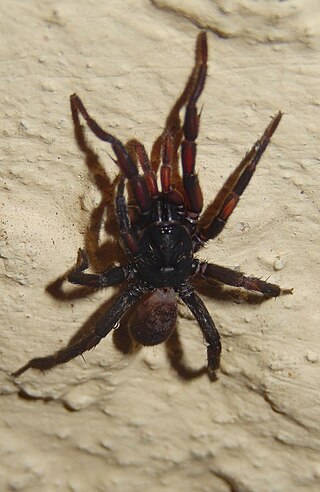
A raven is any of several larger-bodied passerine bird species in the genus Corvus. These species do not form a single taxonomic group within the genus. There is no consistent distinction between "crows" and "ravens", common names which are assigned to different species chiefly based on their size.

The Australian raven is a passerine bird in the genus Corvus native to much of southern and northeastern Australia. Measuring 46–53 centimetres (18–21 in) in length, it has all-black plumage, beak and mouth, as well as strong grey-black legs and feet. The upperparts are glossy, with a purple, blue, or green sheen, and its black feathers have grey bases. The Australian raven is distinguished from the Australian crow species by its throat hackles, which are prominent in adult birds. Older adult individuals have white irises, younger adults have white irises with an inner blue rim, while younger birds have dark brown irises until fifteen months of age, and hazel irises with an inner blue rim around each pupil until age two years and ten months. Nicholas Aylward Vigors and Thomas Horsfield described the Australian raven in 1827, its species name (coronoides) highlighting its similarity with the carrion crow. Two subspecies are recognized, which differ slightly in calls and are quite divergent genetically.

The family Dipluridae, known as curtain-web spiders are a group of spiders in the infraorder Mygalomorphae, that have two pairs of booklungs, and chelicerae (fangs) that move up and down in a stabbing motion. A number of genera, including that of the Sydney funnel-web spider (Atrax), used to be classified in this family but have now been moved to Hexathelidae.

Anaspididae is a family of freshwater crustacean that is endemic to Tasmania, Australia. The family contains 3 genera and 5 species. This group of crustaceans are considered living fossils. They are commonly and collectively known as the Tasmanian anaspid crustaceans. Anaspidids have stalked eyes, long antennae and antennules, and a slender body with no carapace. The two species of Allanaspides and the single species of Paranaspides are all listed as vulnerable on the IUCN Red List.

The spider genus Aname is endemic to Australia, with one species found only on Tasmania. It contains the black wishbone spider, A. atra.
Habronestes is an ant-eating spider genus that occurs only in Australia.
Allanaspides hickmani, also known as Hickman's Pygmy Mountain Shrimp, is a species of mountain shrimp in the family Anaspididae.

Arkys, also known as triangular spider or ambush spider, is a genus of Australian araneomorph spiders in the family Arkyidae, first described by Charles Athanase Walckenaer in 1837. They are often small, with a triangular shaped abdomen, and are found in Australia and some of its surrounding islands. They don't build webs, but can often be found on leaves and tips of flower heads. Their egg sacs are pinkish-orange and spherical, and are made late in the summer.

Notoncus is an Australian genus of ants in the subfamily Formicinae. The genus is known from Australia, where the ants nest in the soil or on the ground under stones and logs in forested areas. The ants are also common in gardens and parks.

Chenistonia caeruleomontana is a ground spider, found in New South Wales, Australia. Spiders in this group are called "wishbone spiders", for the shape of their open silk-lined burrow, which has the shape of the letter "Y", with one arm shorter than the other. Only the longer arm reaches the surface. The shorter arm is believed to allow the spider to survive flooding by trapping an air bubble.

Arkyidae is a family of araneomorph spiders first described by Ludwig Carl Christian Koch in 1872 as a subfamily of Araneidae, and later elevated to a full family in 2017.
Chenistonia is a genus of spiders in the family Anamidae. It was first described in 1901 by Henry Roughton Hogg. As of 2020, it contains 8 species, all from Australia.
Namea is a genus of spiders in the family Anamidae. It is endemic to Australia. It was first described in 1984 by Australian arachnologist Robert Raven. As of 2017, it contains 19 species, all from the states of Queensland (QLD) or New South Wales (NSW).
Tasmanoonops is a genus of Australian araneomorph spiders in the family Orsolobidae, and was first described by V. V. Hickman in 1930.
Flavarchaea is a genus of South Pacific shield spiders that was first described by Michael Gordon Rix in 2006.
Cryptoforis is a genus of Australian armoured trapdoor spiders. It was first described by J. D. Wilson, Robert Raven and Günter E. W. Schmidt in 2020, and it has only been found in Australia.
Chenistonia montana is a species of mygalomorph spider in the Anamidae family. It is endemic to Australia. It was described in 1984 by Australian arachnologist Robert Raven.
Chenistonia maculata is a species of mygalomorph spider in the Anamidae family. It is endemic to Australia. It was described in 1901 by British arachnologist Henry Roughton Hogg.
Chenistonia boranup is a species of mygalomorph spider in the Anamidae family. It is endemic to Australia. It was described in 2012 by Australian arachnologist Barbara York Main.








